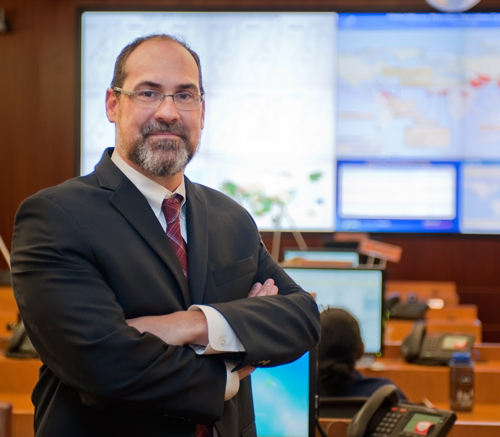CDC Responds to the 2014 Ebola Outbreak: David Kuhar
About CDC
Fighting Ebola: David Kuhar

Dr. David Kuhar says his family understands why they haven’t seen much of him in recent months. But while he makes time to see his wife and young boys every night, he admits that after just completing the MERS-Coronavirus outbreak and then starting the Ebola outbreak, it has been challenging.
Kuhar, an infectious disease specialist, leads the CDC team responsible for healthcare worker safety during the current Ebola outbreak in West Africa. He’s an expert in developing guidance for infection control in U.S. hospitals and for preventing the spread of infection to – and from – healthcare personnel and hospital staff.
And he’s got an important message for U.S. healthcare personnel: Using available personal protective equipment (PPE) and infection prevention procedures that should be familiar, you can safely care for any Ebola patient who may arrive at your workplace.
“What we recommend to prevent transmission of Ebola in hospital settings follows the principles of what we recommend for other infectious diseases,” Kuhar says. “We recommend standard, contact, and droplet precautions.”
In a nutshell this means two things: isolation of the patient in a single-person room with a dedicated bathroom; and, for any personnel who enter the room, to wear gloves, a gown that is fluid resistant, eye protection such as goggles or face shield, and a face mask. Additional equipment may be needed in certain situations if there is a lot of blood, feces, or vomit in the room, such as double gloves, disposable shoe coverings, or leg protection.
But what about those moon suits you see in pictures of healthcare teams in West Africa? Kuhar notes that conditions in West Africa are far different than those in U.S. hospitals. Precautions needed far out in the field are unnecessary in U.S. hospitals, which are more controlled environments. In fact, unfamiliar gear may increase a person’s risk of contaminating their clothes, mouth, or eyes, especially when removing the equipment. If hospitals decide to add additional precautions, they should have staff practice the procedures and use the PPE in advance.
“Use equipment you have practiced putting on and taking off,” Kuhar says. “Changing to unfamiliar equipment may lead to breaches in maintaining safety, which is why practicing equipment use and patient care procedures is important.”
If healthcare workers believe they have been exposed to blood or body fluids from an infected person, they should immediately stop working and wash the affected area with soap and water. If mucous membranes (for example, on the mouth, nose, or eyes) may have been exposed, irrigate them with plenty of water or eyewash. Then the healthcare worker should immediately contact their supervisors for the kind of post-exposure services in place for all infectious diseases that may be spread through body fluids.
How sure is Kuhar that these precautions are enough? Very sure. Ebola isn’t new. There have been outbreaks since the 1970s, and CDC has a great deal of experience managing it.
“We understand how Ebola is transmitted and how to prevent its spread,” Kuhar says.
Read more in CDC’s FAQ on Safe Management of Patients with Ebola in U.S. Hospitals.
##